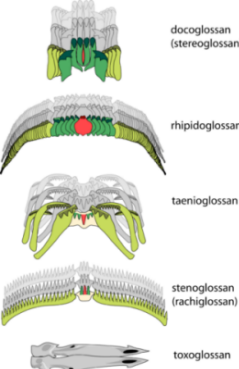
What do they eat?
Nutrition is a key factor and can tell you a lot about an organism that you want to study. Since the specific diet and nutrition for the Mesodon trossulus is unknown this page shares a bit of more general information on snail nutrition, specifically Polygyridae.
Mesodon Trossulus are part of the family Polygyridae. Typically polygyrids diet consist of things like the vegetative or fruiting part of fungi. They also feed on organic decaying matter that is near the leaves of oak trees (Turgeon et. al., 1998).
Snails use sensory receptors located on the skin of their tentacles to smell, taste and touch the nearby surroundings (Nordsieck, 2012). This helps them to get a feel for what environment they are in and deciding what they want to eat.
 Also,
snails use a specialized rasping tongue-like
structure called the radula for feeding and processing food. This
structure exhibits rows of teeth lined up backwards to allow for
more food intake. The radula's surrounding cartilage and muscles are
used to get food into the mouth (Hickman
et. al., 2012).
Also,
snails use a specialized rasping tongue-like
structure called the radula for feeding and processing food. This
structure exhibits rows of teeth lined up backwards to allow for
more food intake. The radula's surrounding cartilage and muscles are
used to get food into the mouth (Hickman
et. al., 2012).
Different radulas posses different numbers and shapes of teeth. The type of radula exhibited by a specific snail depends on the type of nutrition it requires (Nordsieck, 2012).
Gastropods exhibit a complete digestive system. So
they
have a mouth for taking in food and an anus for expelling it from
their body, with many digestive organs in between. These specific digestive
organs in snails include the crop, stomach, digestive gland, and intestine (Hickman
et. al, 2012).
Five different radula types are shown here.